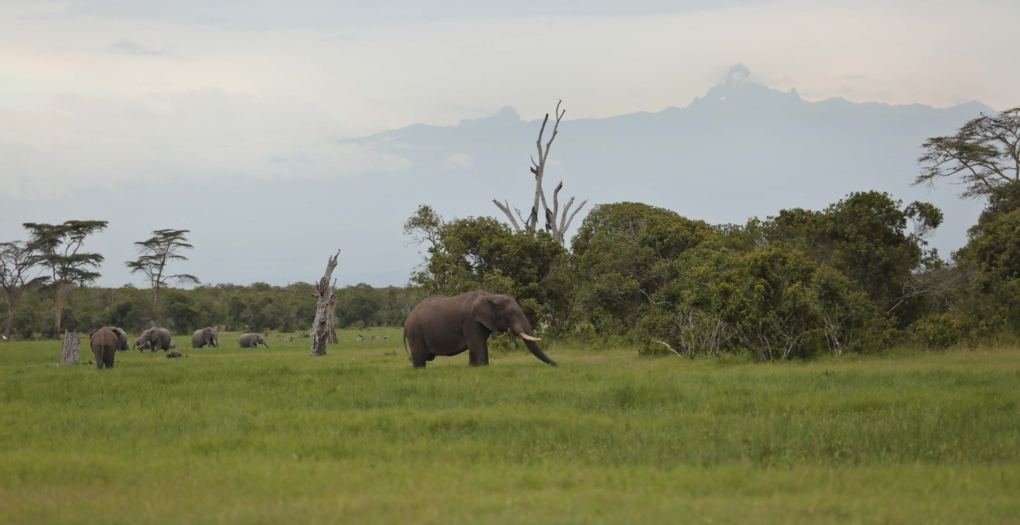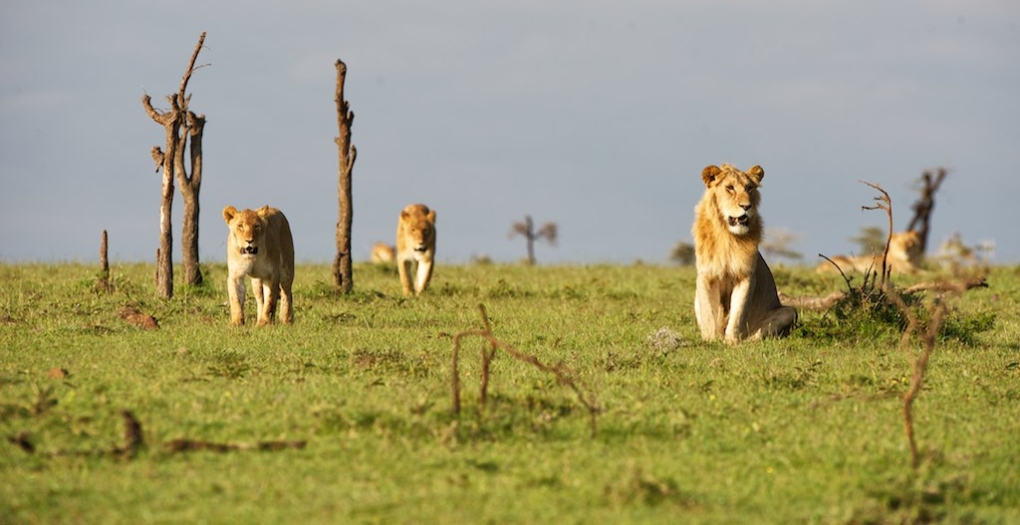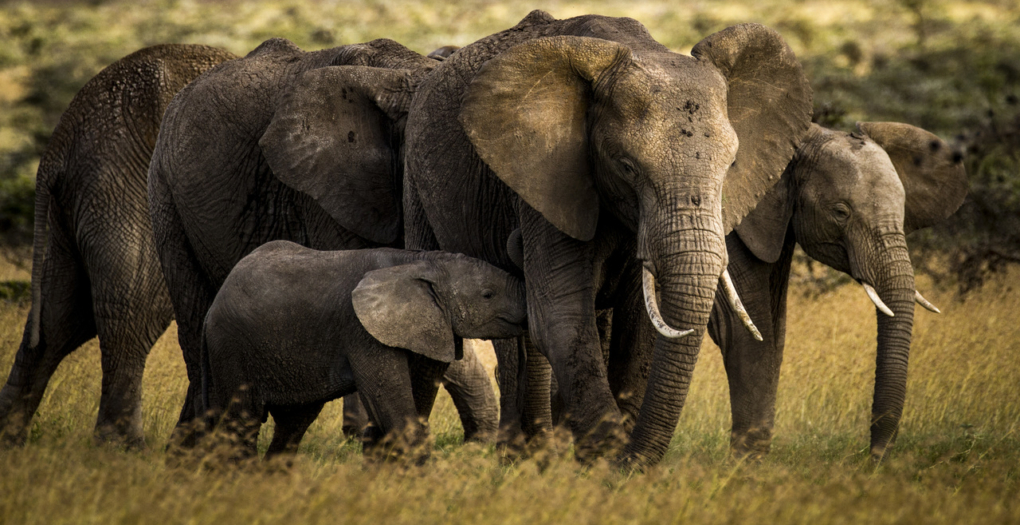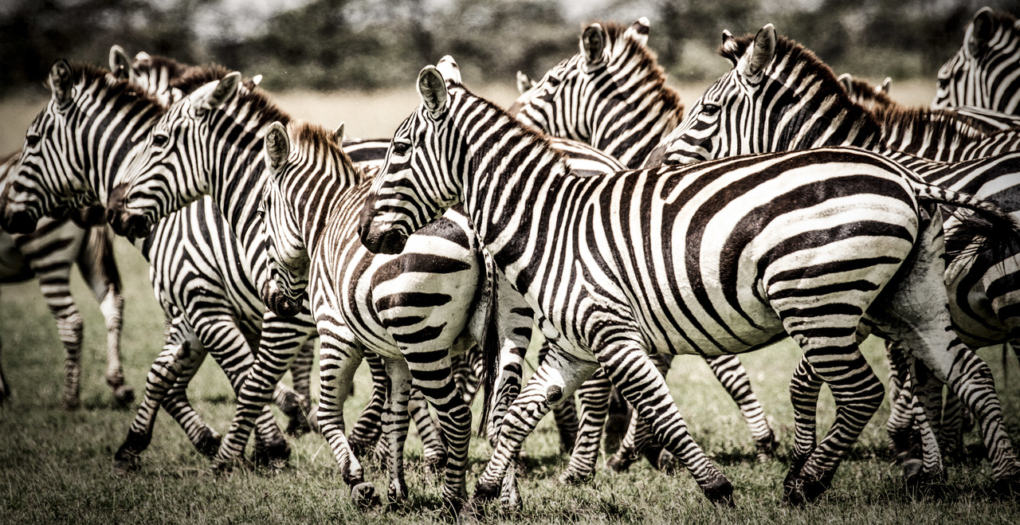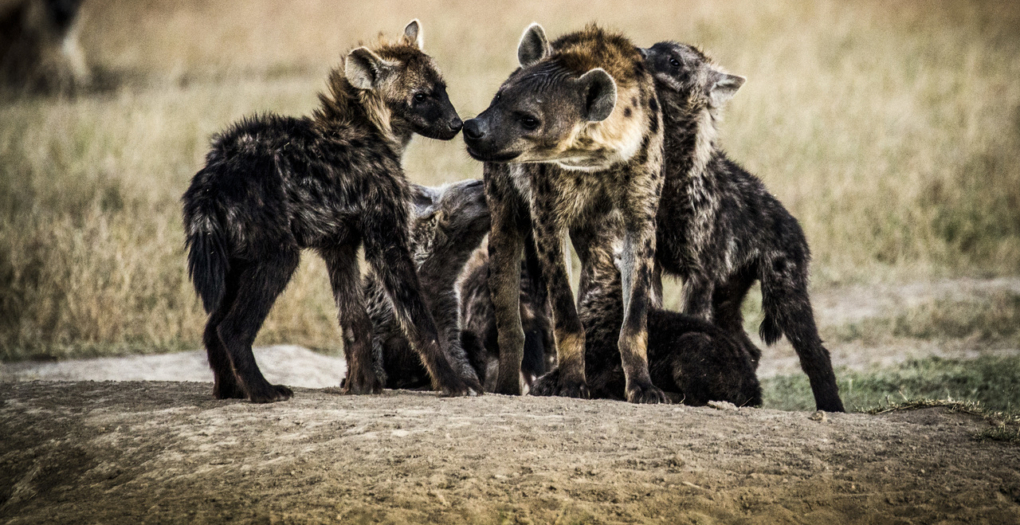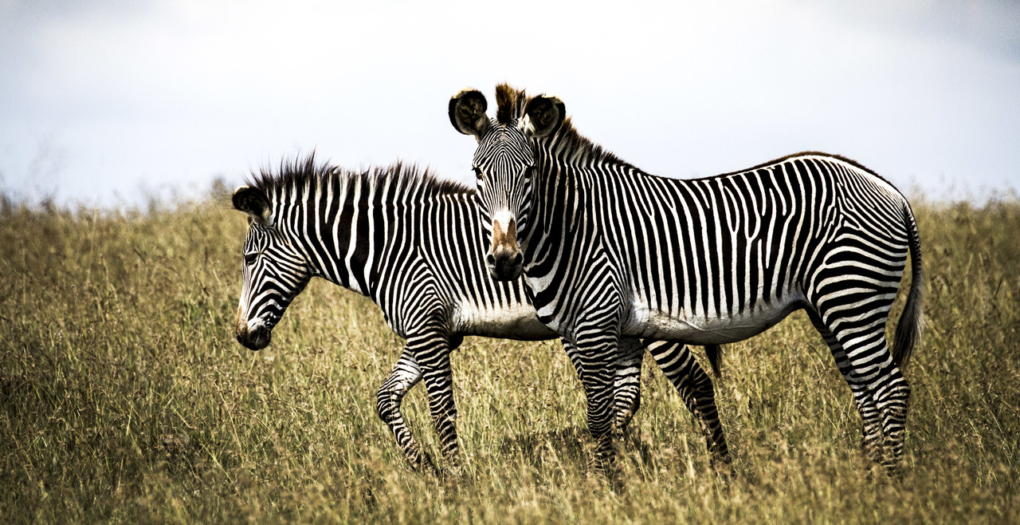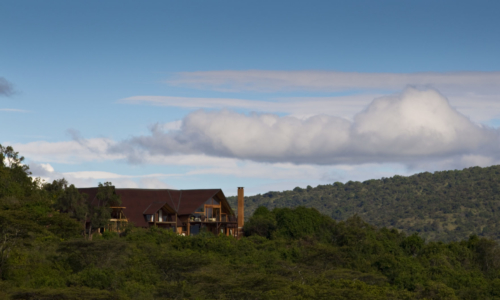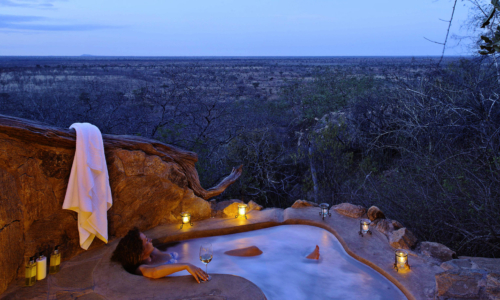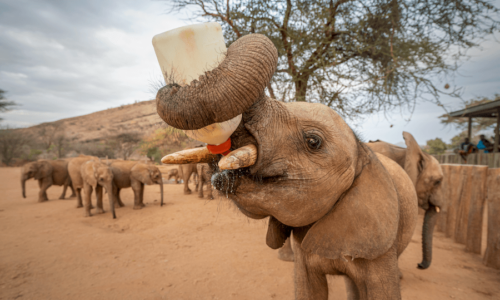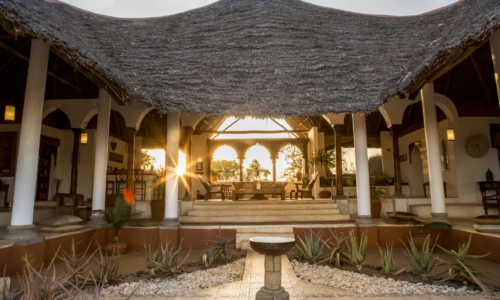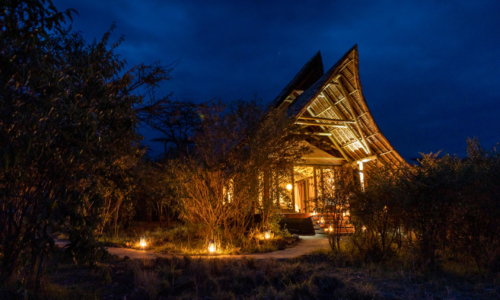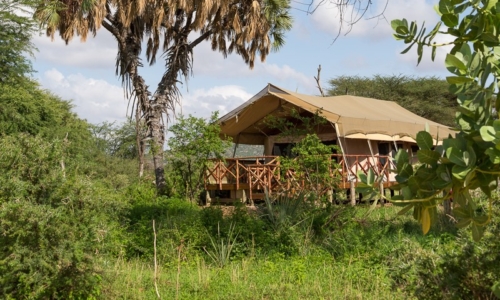Between Mount Kenya and the northern deserts, the high rangelands of Laikipia spread out between north-flowing streams and rivers, which flow during most of the year into the Ewaso Nyiro, northern Kenya’s greatest river. Originally this land was a patch-work of huge ranches, even now it remains an important livestock region. Now it’s a conservation area with growing success in its efforts to protect and maintain the land and wildlife hereabouts. Fees from safaris and nearby camps helps fund efforts to protect the animals, promote small-scale luxury tourism, and generate an income for the local Samburu and Ilaikipiak and Mokogodo Maasai communities.
Due in part to its conservation efforts, Laikipia provides a refuge for a large amount of endangered species. Roughly half of Kenya’s black rhinos, some 600 of them live here. It is also the second most important range for the African wild dogs. A quarter of Africa’s remaining population of Grevy’s zebra also call this part of Kenya home. More than 2,000 elephants migrate between the slopes of Mount Kenya, the Laikipia safari conservancies, and the Samburu region. Because a large number of animals here need to be protected, the local predators often wear radio-collars so trackers can monitor them and keep animals like the endangered black rhino alive and flourishing. Something the conservancies are having great success with.
There are a number of private conservancies within the region, all boasting their own lodges, distinct safaris, and conservation programs. Lewa Conservancy is one of the oldest and is located on the Lewa Downs, a mixture of riverine woodland, scrubby bush and open plains. This excellent range of environments makes for a diverse population of game including more than 65 black and 50 white rhinos, as well as rare sitatunga, a semi-aquatic antelope. Borana Ranch, a former farm is now home to some 300 elephants, four prides of lions, hyenas, and cheetahs. Only 32 people can be on safari at a time here to decrease the impact on the wildlife and landscape. Solio Game Ranch lies in the grasslands between Mount Kenya and the Aberdare Range. More than 70 indigenous black rhino now live here, alongside more than 140 white rhinos.
The Ol Pejeta Conservancy is one of the busiest wildlife sanctuaries, with its rolling short-grass plains with thickets of acacia woodland. The conservancy combines wildlife conservation work, especially the rhinos, with running the world’s largest herd of Boran cattle, Africa’s best beef producer. It also manages a chimpanzee sanctuary with two troops living in relative freedom separated by the Ewaso Nyiro River. These are just some of the successful conservancies located here.


- Amboseli Serena Safari Lodge
- Basecamp Masai Mara
- Bateleur Camp
- Campi ya Kanzi
- Cottar’s 1920s Safari Camp
- Deloraine House
- Eagle View
- Elephant Bedroom Camp
- Elephant Pepper Camp
- Elsa’s Kopje
- Emboo
- Encounter Mara
- Governors’ Camp
- Governors’ Private Camp
- Hemingways Ol Seki Mara Camp
- House in the Wild
- Il Moran Camp
- Il Ngwesi
- Joy’s Camp
- Kicheche Bush
- Kicheche Laikipia
- Kicheche Mara
- Kicheche Valley
- Kichwa Tembo Tented Camp
- Kifaru House Lewa
- Kilaguni Serena Safari Lodge
- Kinondo Kwetu
- Kitich Camp
- Kitirua Plains Lodge
- Lake Elmenteita Serena Camp
- Leopard Hill
- Lewa House
- Lewa Private Wilderness
- Lewa Safari Camp
- Lewa Wilderness Lodge
- Little Governors’ Camp
- Loisaba Lodo Springs
- Loisaba Star Beds
- Loisaba Tented Camp
- Loldia House
- Mahali Mzuri
- Mara Expedition Camp
- Mara Nyika
- Mara Plains Camp
- Mara Serena Safari Lodge
- Mara Toto Tree Camp
- Mfangano Island Camp
- Naboisho Camp
- Ngare Serian
- Offbeat Mara Camp
- Ol Donyo Lodge
- Ol Jogi
- Ol Pejeta Bush Camp
- Ol Pejeta House
- Olare Mara
- Ololo Safari Lodge
- Olonana
- Olonana – Geoffrey Kent Suite
- Rekero Camp
- Reteti House
- Sabuk Lodge
- Sala’s Camp
- Sand River Masai Mara
- Sarara Camp
- Sarara Treehouses
- Sarara Wilderness
- Saruni Mara
- Saruni Rhino
- Saruni Samburu
- Saruni Wild
- Sasaab Camp
- Segera Retreat
- Serian The Original
- Serian’s Nkorombo
- Sirikoi
- Solio Lodge
- Sosian Lodge
- Speke’s Camp
- Tambarare
- Tangulia Mara
- Tawi Lodge
- Tortilis Camp
- Wilderness Mara
- Amboseli Serena Safari Lodge
- Basecamp Masai Mara
- Bateleur Camp
- Campi ya Kanzi
- Cottar’s 1920s Safari Camp
- Deloraine House
- Eagle View
- Elephant Bedroom Camp
- Elephant Pepper Camp
- Elsa’s Kopje
- Emboo
- Encounter Mara
- Governors’ Camp
- Governors’ Private Camp
- Hemingways Ol Seki Mara Camp
- House in the Wild
- Il Moran Camp
- Il Ngwesi
- Joy’s Camp
- Kicheche Bush
- Kicheche Laikipia
- Kicheche Mara
- Kicheche Valley
- Kichwa Tembo Tented Camp
- Kifaru House Lewa
- Kilaguni Serena Safari Lodge
- Kinondo Kwetu
- Kitich Camp
- Kitirua Plains Lodge
- Lake Elmenteita Serena Camp
- Leopard Hill
- Lewa House
- Lewa Private Wilderness
- Lewa Safari Camp
- Lewa Wilderness Lodge
- Little Governors’ Camp
- Loisaba Lodo Springs
- Loisaba Star Beds
- Loisaba Tented Camp
- Loldia House
- Mahali Mzuri
- Mara Expedition Camp
- Mara Nyika
- Mara Plains Camp
- Mara Serena Safari Lodge
- Mara Toto Tree Camp
- Mfangano Island Camp
- Naboisho Camp
- Ngare Serian
- Offbeat Mara Camp
- Ol Donyo Lodge
- Ol Jogi
- Ol Pejeta Bush Camp
- Ol Pejeta House
- Olare Mara
- Ololo Safari Lodge
- Olonana
- Olonana – Geoffrey Kent Suite
- Rekero Camp
- Reteti House
- Sabuk Lodge
- Sala’s Camp
- Sand River Masai Mara
- Sarara Camp
- Sarara Treehouses
- Sarara Wilderness
- Saruni Mara
- Saruni Rhino
- Saruni Samburu
- Saruni Wild
- Sasaab Camp
- Segera Retreat
- Serian The Original
- Serian’s Nkorombo
- Sirikoi
- Solio Lodge
- Sosian Lodge
- Speke’s Camp
- Tambarare
- Tangulia Mara
- Tawi Lodge
- Tortilis Camp
- Wilderness Mara

Between Mount Kenya and the northern deserts, the high rangelands of Laikipia spread out between north-flowing streams and rivers, which flow during most of the year into the Ewaso Nyiro, northern Kenya’s greatest river. Originally this land was a patch-work of huge ranches, even now it remains an important livestock region. Now it’s a conservation area with growing success in its efforts to protect and maintain the land and wildlife hereabouts. Fees from safaris and nearby camps helps fund efforts to protect the animals, promote small-scale luxury tourism, and generate an income for the local Samburu and Ilaikipiak and Mokogodo Maasai communities.
Due in part to its conservation efforts, Laikipia provides a refuge for a large amount of endangered species. Roughly half of Kenya’s black rhinos, some 600 of them live here. It is also the second most important range for the African wild dogs. A quarter of Africa’s remaining population of Grevy’s zebra also call this part of Kenya home. More than 2,000 elephants migrate between the slopes of Mount Kenya, the Laikipia safari conservancies, and the Samburu region. Because a large number of animals here need to be protected, the local predators often wear radio-collars so trackers can monitor them and keep animals like the endangered black rhino alive and flourishing. Something the conservancies are having great success with.
There are a number of private conservancies within the region, all boasting their own lodges, distinct safaris, and conservation programs. Lewa Conservancy is one of the oldest and is located on the Lewa Downs, a mixture of riverine woodland, scrubby bush and open plains. This excellent range of environments makes for a diverse population of game including more than 65 black and 50 white rhinos, as well as rare sitatunga, a semi-aquatic antelope. Borana Ranch, a former farm is now home to some 300 elephants, four prides of lions, hyenas, and cheetahs. Only 32 people can be on safari at a time here to decrease the impact on the wildlife and landscape. Solio Game Ranch lies in the grasslands between Mount Kenya and the Aberdare Range. More than 70 indigenous black rhino now live here, alongside more than 140 white rhinos.
The Ol Pejeta Conservancy is one of the busiest wildlife sanctuaries, with its rolling short-grass plains with thickets of acacia woodland. The conservancy combines wildlife conservation work, especially the rhinos, with running the world’s largest herd of Boran cattle, Africa’s best beef producer. It also manages a chimpanzee sanctuary with two troops living in relative freedom separated by the Ewaso Nyiro River. These are just some of the successful conservancies located here.

- Amboseli Serena Safari Lodge
- Basecamp Masai Mara
- Bateleur Camp
- Campi ya Kanzi
- Cottar’s 1920s Safari Camp
- Deloraine House
- Eagle View
- Elephant Bedroom Camp
- Elephant Pepper Camp
- Elsa’s Kopje
- Emboo
- Encounter Mara
- Governors’ Camp
- Governors’ Private Camp
- Hemingways Ol Seki Mara Camp
- House in the Wild
- Il Moran Camp
- Il Ngwesi
- Joy’s Camp
- Kicheche Bush
- Kicheche Laikipia
- Kicheche Mara
- Kicheche Valley
- Kichwa Tembo Tented Camp
- Kifaru House Lewa
- Kilaguni Serena Safari Lodge
- Kinondo Kwetu
- Kitich Camp
- Kitirua Plains Lodge
- Lake Elmenteita Serena Camp
- Leopard Hill
- Lewa House
- Lewa Private Wilderness
- Lewa Safari Camp
- Lewa Wilderness Lodge
- Little Governors’ Camp
- Loisaba Lodo Springs
- Loisaba Star Beds
- Loisaba Tented Camp
- Loldia House
- Mahali Mzuri
- Mara Expedition Camp
- Mara Nyika
- Mara Plains Camp
- Mara Serena Safari Lodge
- Mara Toto Tree Camp
- Mfangano Island Camp
- Naboisho Camp
- Ngare Serian
- Offbeat Mara Camp
- Ol Donyo Lodge
- Ol Jogi
- Ol Pejeta Bush Camp
- Ol Pejeta House
- Olare Mara
- Ololo Safari Lodge
- Olonana
- Olonana – Geoffrey Kent Suite
- Rekero Camp
- Reteti House
- Sabuk Lodge
- Sala’s Camp
- Sand River Masai Mara
- Sarara Camp
- Sarara Treehouses
- Sarara Wilderness
- Saruni Mara
- Saruni Rhino
- Saruni Samburu
- Saruni Wild
- Sasaab Camp
- Segera Retreat
- Serian The Original
- Serian’s Nkorombo
- Sirikoi
- Solio Lodge
- Sosian Lodge
- Speke’s Camp
- Tambarare
- Tangulia Mara
- Tawi Lodge
- Tortilis Camp
- Wilderness Mara
- Amboseli Serena Safari Lodge
- Basecamp Masai Mara
- Bateleur Camp
- Campi ya Kanzi
- Cottar’s 1920s Safari Camp
- Deloraine House
- Eagle View
- Elephant Bedroom Camp
- Elephant Pepper Camp
- Elsa’s Kopje
- Emboo
- Encounter Mara
- Governors’ Camp
- Governors’ Private Camp
- Hemingways Ol Seki Mara Camp
- House in the Wild
- Il Moran Camp
- Il Ngwesi
- Joy’s Camp
- Kicheche Bush
- Kicheche Laikipia
- Kicheche Mara
- Kicheche Valley
- Kichwa Tembo Tented Camp
- Kifaru House Lewa
- Kilaguni Serena Safari Lodge
- Kinondo Kwetu
- Kitich Camp
- Kitirua Plains Lodge
- Lake Elmenteita Serena Camp
- Leopard Hill
- Lewa House
- Lewa Private Wilderness
- Lewa Safari Camp
- Lewa Wilderness Lodge
- Little Governors’ Camp
- Loisaba Lodo Springs
- Loisaba Star Beds
- Loisaba Tented Camp
- Loldia House
- Mahali Mzuri
- Mara Expedition Camp
- Mara Nyika
- Mara Plains Camp
- Mara Serena Safari Lodge
- Mara Toto Tree Camp
- Mfangano Island Camp
- Naboisho Camp
- Ngare Serian
- Offbeat Mara Camp
- Ol Donyo Lodge
- Ol Jogi
- Ol Pejeta Bush Camp
- Ol Pejeta House
- Olare Mara
- Ololo Safari Lodge
- Olonana
- Olonana – Geoffrey Kent Suite
- Rekero Camp
- Reteti House
- Sabuk Lodge
- Sala’s Camp
- Sand River Masai Mara
- Sarara Camp
- Sarara Treehouses
- Sarara Wilderness
- Saruni Mara
- Saruni Rhino
- Saruni Samburu
- Saruni Wild
- Sasaab Camp
- Segera Retreat
- Serian The Original
- Serian’s Nkorombo
- Sirikoi
- Solio Lodge
- Sosian Lodge
- Speke’s Camp
- Tambarare
- Tangulia Mara
- Tawi Lodge
- Tortilis Camp
- Wilderness Mara







